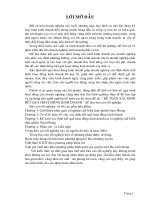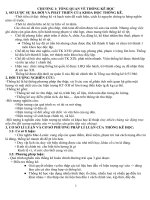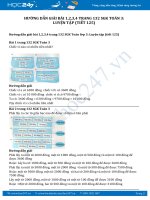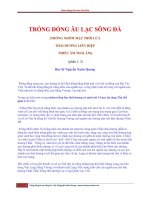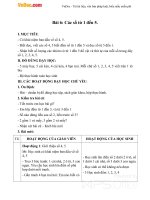Slide 1 2 3 4
Bạn đang xem bản rút gọn của tài liệu. Xem và tải ngay bản đầy đủ của tài liệu tại đây (1.69 MB, 65 trang )
INTERNATIONAL INVESTMENT
Instructor: Lu Thi Thu Trang (LL.M.)
Slides by Pham Thi Mai Khanh-FTU
1
05/27/19
2
COURSE DISCRIPTION
CONCEPTS AND PRINCIPLES OF
INTERNATIONAL INVESTMENT FLOWS:
ODA, FDI, FPI, IPL
FOCUS: FDI, ITS RATIONALES,
NATIONAL AND INTERNATIONAL RULES
05/27/19
Slides by Pham Thi Mai KhanhFTU
3
COURSE OBJECTIVES
Understand the concepts, features,
the economic rationales and trends of
main categories of international
investment flows.
Analyze the roles of FDI in
development, its determinants, and
the national and international rules
regulating FDI flows.
05/27/19
Slides by Pham Thi Mai Khanh-FTU
4
COURSE STRUCTURE
I.
AN OVERVIEW OF INTERNATIONAL
INVESTMENT
II. ECONOMIC ASPECTS OF FOREIGN
DIRECT INVESTMENT
III. POLICY ASPECTS OF FOREIGN DIRECT
INVESTMENT
IV. KEY ISSUES AND FEATURES IN
INTERNATIONAL INVESTMENT
AGREEMENTS
05/27/19
Slides by Pham Thi Mai Khanh-FTU
5
READING LISTS
UNCTAD, Virtual Institute Teaching
Material on Economic and Legal
Aspects of Foreign Direct Investment,
New York and Geneva, 2010
Vu Chi Loc et al., International
Investment, Chapter 2, 2011 (in
Vietnamese)
05/27/19
Slides by Pham Thi Mai Khanh-FTU
6
GRADING
Class attendance and participation:
10%
Team project: 30%
Final test: 60%
05/27/19
Slides by Pham Thi Mai Khanh-FTU
7
Part I:
AN OVERVIEW OF
INTERNATIONAL INVESTMENT
05/27/19
Slides by Pham Thi Mai Khanh-FTU
8
STRUCTURE
I.
The concepts of Investment, Foreign
Investment and International Investment
II.
Taxonomy of International Investment Flows
05/27/19
Slides by Pham Thi Mai Khanh-FTU
9
I. The concepts of Investment, Foreign
Investment and International Investment
What is Investment???
05/27/19
Slides by Pham Thi Mai Khanh-FTU
10
It takes money to make
money!
05/27/19
Slides by Pham Thi Mai Khanh-FTU
11
INVESTMENT
• You sacrifice something of value now,
expecting to benefit from that sacrifice later.
Current resources
(Capital)
Future benefits
Financial benefits
Social benefits
Investment
• “An Investment is the current commitment of
money or other resources in the expectation of
reaping future benefits.”
Z. Bodie, A. Kane and A. J. Marcus, Investments, 8th edition, Mc Graw-Hill Irwin,
2009
• “A sum of money or other resources (including e.g.
knowledge or time) spent with the expectation of
getting a future return from it.”
UNCTAD, Virtual institute teaching Material on ECONOMIC AND LEGAL
ASPECTS OF FOREIGN DIRECT INVESTMENT, United Nations: New York
and Geneva, 2010
(UNCTAD, 2010) 3 approaches:
(a) In macro-economics and national accounts:
expenditure on new capital goods (goods that are not consumed but
instead used in future production). Such investment is the source of
new employment and economic growth.
(b) In finance:
investment refers to the purchase or ownership of a financial asset
with the expectation of a future return either as income (such as
dividends), or as capital gain (such as a rise in the value of the stock).
(c) Legal definitions of investment:
found in laws and legal agreements, focus on the issue of property,
notwithstanding the productive or financial nature of the investment,
unless specific limitations are made.
Financial Assets vs. Real assets
Real assets
Financial Assets
E.g. Land, buildings, machines,
knowledge
- Can be used to produce goods
and services.
- Can be tangible and intangible
- Generate net income for the
economy, contribute directly to
the productive capacity of the
economy.
E.g. Shares, bonds,…
- Means by which individuals
hold their claims on real assets.
-Claims on the income generated
by/derived from real assets (or
claims on the income from the
government).
-Define the allocation of income
or wealth among investors.
Composition of national wealth
• Shares and bonds are financial assets of
individuals/households but are liabilities of the
issuers of the securities.
When we aggregate over all balance sheets,
these claims cancel out, leaving only real
assets as the net wealth of the economy.
• National wealth consists of structures,
equipment, inventories of goods, and land
Methodology to measure effective use of capital
An individual project: ROI
(Return on Investment)
ROI = Profit/Total Investment
(Profit = Turnover - Cost)
A country: ICOR
(Incremental Capital Output Ratio)
ICORt = Total Investment/Δ GDP
(Δ GDP = GDPt- GDPt-1 )
05/27/19
Slides by Pham Thi Mai Khanh-FTU
17
Harrod-Domar Model
developed by both
Domar
Harrod
and
g = k/ICOR
05/27/19
Slides by Pham Thi Mai Khanh-FTU
18
Harrod Dormar model
I
k
GDP
GDP
g
GDP
k
I
ICOR
g
GDP
(Total Investment = Domestic Investment + Foreign
Investment)
05/27/19
Slides by Pham Thi Mai Khanh-FTU
19
Harrod-Domar Model
g = k/ICOR
Growth rate of an economy:
- positively related to the saving rates
(investment rate)
- negatively related to ICOR (the
economy’s capital-output ratio)
Increase Investment increase
economic growth
05/27/19
Slides by Pham Thi Mai Khanh-FTU
20
Exercises
For a country in 2010, ICOR has a value of 5,
GDP per capita is 1000 USD/year with the
population of 85 million people.
(a)The growth rate of this country is 6% in
comparison to the previous year (2009).
How much is the total investment of that
country?
(b)If the expected annual growth rate is 6% for
the period from 2010 to 2015. How much is
the total investment for that country?
05/27/19
Slides by Pham Thi Mai Khanh-FTU
21
ICOR’s Implication
Development strategy (calculate the
investment needed to get the targeted
economic growth)
Compare the effectiveness of using
capital in an economy
Higher ICOR , lesser effective use of
capital
05/27/19
Slides by Pham Thi Mai Khanh-FTU
22
Vietnam’s ICOR
Period
ICOR
1991
1996
2001
2004
1995
2000
2003
2006
3,5
4,8
5,24
2007
5,04
2008
5,2
2009
6,66
2010
8,0
6,5
Source: General Statistics of Vietnam
05/27/19
Slides by Pham Thi Mai Khanh-FTU
23
Characteristics of investment?
- Capital
- Profitability
- Risk
05/27/19
Slides by Pham Thi Mai Khanh-FTU
24
INVESTMENT TAXONOMY
Official Flows of Investment
Private Investment
Domestic Investment
Foreign Investment
Direct investment
Indirect investment
Productive investment (contribute directly to the productive
capacity of the economy)
Financial Investment (do not contribute directly to the
productive capacity of the economy)

